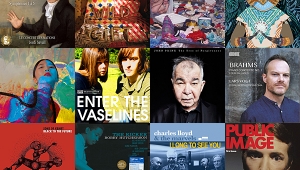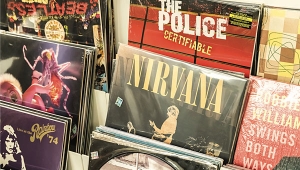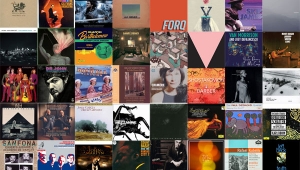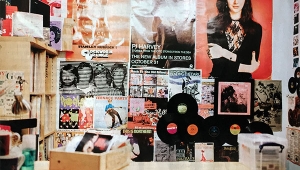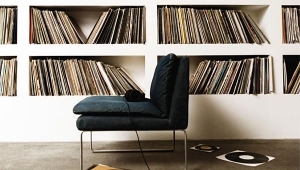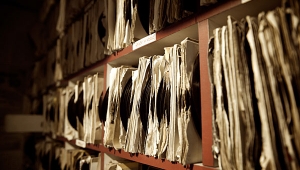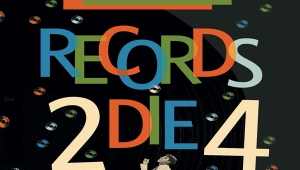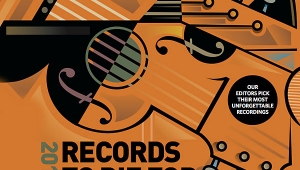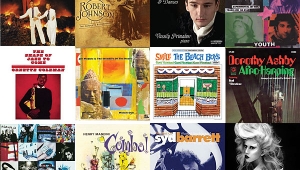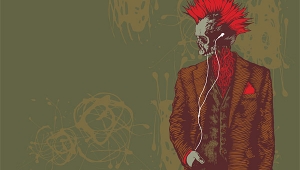| Columns Retired Columns & Blogs |
1992 Records To Die For Page 13
Arnis Balgalvis
SONNY BOY WILLIAMSON: Keep It To Ourselves
Alligator AL4787 (LP), ALCD 4878 (CD). Ivar Rosenberg, eng.; Karl Emil Knudsen, prod. AAA/A?D. TT: 51:36
This is a U-R-There recording if ever there was one. I don't know what rivets me more: the absolutely compelling performance or the outstanding sonic presentation. If this doesn't transport Sonny Boy into your listening room and give you frequent glimpses of reality, I don't know what will. The harmonica is simply a part of this remarkable artist, and you are sure to be part of the rapt audience. Despite some adventuresome sibilants, and the fact that not all tracks have been created equal, this is a rare treat.
AHMAD JAMAL: Rossiter Road
Atlantic 81645-1 (LP), -2 (CD). Joe Jorgensen, eng.; Ahmad Jamal, Laura Hess-Hay, prods. AAA/A?D. TT: 41:25
Bill Brassington should know better than to play me a fantastic CD like this one. It never fails: he rushes in to play his latest discovery---only Apogee's Jason Bloom is better at picking out great recordings---only to have me confiscate it. What are friends for, anyway?
John Atkinson
According to the venerable JGH (in whose ears we trust), high-fidelity sound reproduction and classical orchestral music from the Romantic era---approximately from Beethoven's Symphony 9 to Vaughan Williams's Symphony 9---were made for each other. Yet this is the kind of music that I find to be less than well-served by even the highest of high-end playback systems. This might be thought due to the huge suspension of disbelief required to accommodate the image of over 100 musicians and singers at the end of your listening room. It is probably more due, however, to the compromises made by recording engineers to make the immense sound that that many people produce live suitable for playback on a mid-fi system in a domestic room. Both my choices, therefore, are single-carat rather than hen's-egg-sized gems: both are flawless, nevertheless; one is classical, the other unclassifiable (except that it isn't classical).
VIVALDI: Concerti for Wind & Strings
Iona Brown, violin; William Bennett, flute; Martin Gatt, bassoon; Celia Nicklin, Neil Black, oboes; Christopher Hogwood, harpsichord continuo; Simon Preston, organ continuo; Academy of St. Martin-in-the-Fields, Sir Neville Marriner
Argo ZRG 839 (LP), London Jubilee 417 777-2 (CD). Chris Hazell, prod.; Stan Goodall, John Dunkerley, eng. AAA/ADD. TT: 43:04
My choice was originally going to be the 1971 Louis Frémaux/CBSO performance of the ballet music from Massenet's Le Cid. Originally an EMI Studio Two, SQ-encoded surround-sound recording, it was rereleased as an excellent EMI "Greensleeve" LP in 1977 (ESD 7040). In 1991, Acoustic Sounds' Chad Kassem issued a Doug Sax-remastered LP of this recording (AKLA 522) that Stereophile's Robert Hesson went ga-ga over (in Vol.14 No.5). But then I found at an estate sale a mint copy of this all-star Vivaldi collection (for the premium sum of $1.75) to supplement the well-worn copy I've been playing since I reviewed it in Hi-Fi News & Record Review nearly 15 years ago. Obviously a sign from on high that I should leave the Massenet for next year.
RY COODER: Chicken Skin Music
Ry Cooder, guitars, mandolin; Flaco Jimenez, accordion; Gabby Pahinui, steel guitar; Henry "Big Red" Ojeda, double bass; Chris Etheridge, bass guitar; Jim Keltner, drums; Milt Holland, percussion; Oscar Brashear, trumpet; Pat Rizzo, Fred Johnson, George Bohanon, sax; Benny Powell, trombone; Red Callendar, tuba; Bobby King, Terry Evans (Footnote 3), Russ Titelman, Herman Johnson, Cliff Givens, backing vocals (Footnote 4)
Reprise MS-2254 (LP), 2254-2 (CD), K54083 (UK LP). Ry Cooder, prod. AAA/ADD. TT: 39:30
I once played this 1976 album, Cooder's fifth and his first to be self-produced, to a friend who dismissed it on the grounds that he wasn't much interested in "country music." Well, a) there's nothing so personal as musical taste, and b) he had a point. Chicken Skin Music certainly isn't rock, and if this rock guitarist's mix of country swing, Tex-Mex, gospel, and gittar pickin'n'slidin' is, if anything at all, music of the country. (Some would call it "folk" music, but I lost patience with formal folk about the time Pete Seeger and Joan Baez decided that what they were doing was IMPORTANT and SOCIALLY SIGNIFICANT and that their listeners better not forget that fact.)
Footnote 2: And who, incidentally, was one of the first professional audio engineers of my acquaintance to own up that the Meridian MCD Pro sounded much better than a stock Philips, meaning that bits can't always be bits.
Larry Archibald
With one record pre-decided upon---Amazing Grace---I felt arbitrarily that the second should be one from the classical repertoire. In both the classical and non-classical repertoire I feel the restriction to stereo records is both unreasonable and, more important, irrelevant. It's obvious to anyone who listens to music recorded before 1958 that many of the best performances are available only in mono. However, it's also true that many fine recordings are available in mono. The lack of a stereo spread, and the three-dimensional illusion which can only truly be suggested by two channels (and even better portrayed by more), only eliminates one element of what constitutes good recording. A good recording needs to capture a performance's inner spiritual essence and keep the sound quality from interfering with your perception of that performance. Many mono recordings do just that; their lack of stereo spread constitutes a minor discrepancy. Many excellent stereo recordings incorporate more serious flaws.
J.S. BACH: Sonatas & Partitas for Unaccompanied Violin
Arthur Grumiaux, violin
Philips PHS 2-900 (in mono, PHM 2-500)
These records combine fabulous cover art with music made by an extraordinarily accomplished violinist playing a noble Stradivarius. For those who know Bach, the music requires no explanation. For those who do not, the unaccompanied sonatas and partitas are among the most beautiful, serene, intellectual, and difficult pieces of classical music in existence. They entrance and mesmerize; they're lyrical; they stimulate. I've heard many versions of this music, but of them all, this is the best. Although I haven't seen a CD version of this performance, I recently came across a used stereo LP version at a garage sale, to accompany the mono records I've owned since the early '60s. (In those days I carefully bought mono since I felt that stereo was a newfangled gimmick to get us to buy extra amplifiers and speakers.) Don't pass it up. But if you can't find this one, spend some time with a version from any famous violinist. This music is difficult to play, and close to miraculous when played extraordinarily, as here. The recording is like the music: naked and austere. You'll be mainlining the purest form of Bach.
ARETHA FRANKLIN: Amazing Grace
With James Cleveland & the Southern California Community Choir
Atlantic SD 2-906 (2 LPs), 906-2 (CD).
Everyone should hear and attend to this record, if only you can open your heart to the "real truth" of gospel music (this phrase from the religious narrative which accompanies this music).
SONNY BOY WILLIAMSON: Keep It To Ourselves
Alligator AL4787 (LP), ALCD 4878 (CD). Ivar Rosenberg, eng.; Karl Emil Knudsen, prod. AAA/A?D. TT: 51:36
This is a U-R-There recording if ever there was one. I don't know what rivets me more: the absolutely compelling performance or the outstanding sonic presentation. If this doesn't transport Sonny Boy into your listening room and give you frequent glimpses of reality, I don't know what will. The harmonica is simply a part of this remarkable artist, and you are sure to be part of the rapt audience. Despite some adventuresome sibilants, and the fact that not all tracks have been created equal, this is a rare treat.
AHMAD JAMAL: Rossiter Road
Atlantic 81645-1 (LP), -2 (CD). Joe Jorgensen, eng.; Ahmad Jamal, Laura Hess-Hay, prods. AAA/A?D. TT: 41:25
Bill Brassington should know better than to play me a fantastic CD like this one. It never fails: he rushes in to play his latest discovery---only Apogee's Jason Bloom is better at picking out great recordings---only to have me confiscate it. What are friends for, anyway?
Having heard it a good hundred times by now (it's become one of my test discs), I know that great sonics are not enough to get me through the night. The marvelous musicianship exhibited here is why I've yet to tire of Rossiter Road.
Ahmad Jamal is a master at peaking the intensity of his piano with astonishingly complex chordal crashes. He also has the touch to bring you down to kinder, gentler levels. Superb support from his percussionist, drummer, and bassist make this one of the more remarkable journeys through the world of jazz piano.
No part of the sonic spectrum is missed; the dynamics are exhilarating, and clarity, even during the most exuberant transient outbursts, is impeccable. Kudos to whomever handled the air and reverb departments of this studio recording---excellent judgment and good taste.
John Atkinson
According to the venerable JGH (in whose ears we trust), high-fidelity sound reproduction and classical orchestral music from the Romantic era---approximately from Beethoven's Symphony 9 to Vaughan Williams's Symphony 9---were made for each other. Yet this is the kind of music that I find to be less than well-served by even the highest of high-end playback systems. This might be thought due to the huge suspension of disbelief required to accommodate the image of over 100 musicians and singers at the end of your listening room. It is probably more due, however, to the compromises made by recording engineers to make the immense sound that that many people produce live suitable for playback on a mid-fi system in a domestic room. Both my choices, therefore, are single-carat rather than hen's-egg-sized gems: both are flawless, nevertheless; one is classical, the other unclassifiable (except that it isn't classical).
VIVALDI: Concerti for Wind & Strings
Iona Brown, violin; William Bennett, flute; Martin Gatt, bassoon; Celia Nicklin, Neil Black, oboes; Christopher Hogwood, harpsichord continuo; Simon Preston, organ continuo; Academy of St. Martin-in-the-Fields, Sir Neville Marriner
Argo ZRG 839 (LP), London Jubilee 417 777-2 (CD). Chris Hazell, prod.; Stan Goodall, John Dunkerley, eng. AAA/ADD. TT: 43:04
My choice was originally going to be the 1971 Louis Frémaux/CBSO performance of the ballet music from Massenet's Le Cid. Originally an EMI Studio Two, SQ-encoded surround-sound recording, it was rereleased as an excellent EMI "Greensleeve" LP in 1977 (ESD 7040). In 1991, Acoustic Sounds' Chad Kassem issued a Doug Sax-remastered LP of this recording (AKLA 522) that Stereophile's Robert Hesson went ga-ga over (in Vol.14 No.5). But then I found at an estate sale a mint copy of this all-star Vivaldi collection (for the premium sum of $1.75) to supplement the well-worn copy I've been playing since I reviewed it in Hi-Fi News & Record Review nearly 15 years ago. Obviously a sign from on high that I should leave the Massenet for next year.
Someone once said that Vivaldi wrote the same concerto 200 times, and occasionally, to the listener lost in some endlessly over-familiar baroque note-spinning, that indeed seems to be the case. The four works on this classic Argo recording, however, performed from editions prepared by Christopher Hogwood, are as diverse as it is possible to be within the same old concertino vs ripieno formula. Side two, with the A-minor Bassoon Concerto and C-minor Treble Recorder Concerto (performed here on modern flute), is more emotionally laden than side one, which features two works in the brighter key of F-major: one for oboe, the other, lesser work for oboes, bassoons, horns, and violin. All concerned, however, produce stunningly beautiful, virtuosic performances; were it not for the fact they were soon to be eclipsed by "authentic" recordings from members of the original-instruments movement, these would have become widely fêted.
The engineers---Stan Goodall, who was then (and perhaps still is) Argo's house engineer, and John Dunkerley, who went on to find fame if perhaps not fortune by subsequently engineering the commercially successful original-instruments recordings on L'Oiseau-Lyre (Footnote 2)--have captured the instrumental sounds within the admittedly rather washy acoustic of London's St. John's, Smith Square, with a delicious verisimilitude. Before I moved to the US, this was one of my favorite concert venues, its delightful ambience almost always reinforcing rather than fighting the music. On this disc, the sounds are true---the strings, in particular, are luminous---and the individual images of solo instruments are small but precisely positioned within a reverberant dome of sound. The continuo harpsichord is set back, without any exaggeration of its volume, yet it propels the music along to a nicety. True, there is a bit more traffic noise than some might like---St. John's is a mere block away from the Houses of Parliament---but that's something you'd hear live, of course.
This music may not plumb the intellectual depths of Mahler, Brahms, or Wagner, but on its own terms, supported by tasteful and talented engineering, it succeeds completely. A small but perfectly cut diamond.
RY COODER: Chicken Skin Music
Ry Cooder, guitars, mandolin; Flaco Jimenez, accordion; Gabby Pahinui, steel guitar; Henry "Big Red" Ojeda, double bass; Chris Etheridge, bass guitar; Jim Keltner, drums; Milt Holland, percussion; Oscar Brashear, trumpet; Pat Rizzo, Fred Johnson, George Bohanon, sax; Benny Powell, trombone; Red Callendar, tuba; Bobby King, Terry Evans (Footnote 3), Russ Titelman, Herman Johnson, Cliff Givens, backing vocals (Footnote 4)
Reprise MS-2254 (LP), 2254-2 (CD), K54083 (UK LP). Ry Cooder, prod. AAA/ADD. TT: 39:30
I once played this 1976 album, Cooder's fifth and his first to be self-produced, to a friend who dismissed it on the grounds that he wasn't much interested in "country music." Well, a) there's nothing so personal as musical taste, and b) he had a point. Chicken Skin Music certainly isn't rock, and if this rock guitarist's mix of country swing, Tex-Mex, gospel, and gittar pickin'n'slidin' is, if anything at all, music of the country. (Some would call it "folk" music, but I lost patience with formal folk about the time Pete Seeger and Joan Baez decided that what they were doing was IMPORTANT and SOCIALLY SIGNIFICANT and that their listeners better not forget that fact.)
Opening and closing with arrangements of Leadbelly songs---"The Bourgeois Blues" and "Goodnight Irene," respectively---Chicken Skin Music is American music, in some of all its wide variety, gently played with love and respect, as if it were classical music no less. Listen to the parallel-picked guitar chords at the start of "Always Lift Him Up," then the solo, underpinned with soft swept strumming as it stretches the song's structure at the climax of the coda, and you'll hear what I mean. And nearly all these songs end, with coda and cadence, not fade away.
To some, Ry Cooder reached the pinnacle of his exploration into the American people's music ethos with 1978's Jazz (BSK-3197/3197-2, LP/CD), but there is a raw edge to CSM, underlined by Jim Keltner's crushed-roll-on-the-beat set against guitar-back-beat drumming---I still can't believe this is the flamboyant Keltner of Sheffield Drum Record fame---that just sets my veins afire. And the emotional temperature reaches its highest point in the "bom, bom-bom" baion rhythms of the drastically altered C&W standard "He'll Have to Go." In my musician days, I played this song night after endless night behind country singers on the UK's USAF NCO club circuit, yet it was only when I heard the compelling unison obbligato of Flaco Jimenez's accordion and Pat Rizzo's alto sax that I realized what a fundamentally beautiful piece of songwriting it is, the lyric's bathos hiding an iron fist in the velvet glove: "Put your sweet lips a little closer to the phone / And let's pretend we're together, all alone / I'll tell the man to turn the jukebox way down low / And you can tell your friend there with you, he'll have to go"---this is folk music, not the white-bread intellectualizing on the Weavers' Reunion album.
Soundwise, voices and instruments are recorded straight, with minimal processing. Both bass guitar and drums are a little laid-back, with the cymbals set back in the image, but what the heck, the better your system, the better this gem will sound.
Footnote 2: And who, incidentally, was one of the first professional audio engineers of my acquaintance to own up that the Meridian MCD Pro sounded much better than a stock Philips, meaning that bits can't always be bits.
Footnote 3: I heartily endorse last year's selection by RL of Bobby King's & Terry Evans's Live and Let Live!.
Footnote 4: With Chicken Skin Music's UK sleeve and liner devoid of anything other than pictures of a copulating mariacho morte, I put together the band listing from Terry Hounsome's excellent New Rock Record, published in 1983 by Blandford Press in the UK. If this book is available in the US---the Omaha Rainbow apparently referred to it as "an insane and magnificent triumph!," sez the jacket---go and buy it now.
Larry Archibald
With one record pre-decided upon---Amazing Grace---I felt arbitrarily that the second should be one from the classical repertoire. In both the classical and non-classical repertoire I feel the restriction to stereo records is both unreasonable and, more important, irrelevant. It's obvious to anyone who listens to music recorded before 1958 that many of the best performances are available only in mono. However, it's also true that many fine recordings are available in mono. The lack of a stereo spread, and the three-dimensional illusion which can only truly be suggested by two channels (and even better portrayed by more), only eliminates one element of what constitutes good recording. A good recording needs to capture a performance's inner spiritual essence and keep the sound quality from interfering with your perception of that performance. Many mono recordings do just that; their lack of stereo spread constitutes a minor discrepancy. Many excellent stereo recordings incorporate more serious flaws.
Anyway, off the soapbox and on to the recordings. My first choice for the latter has been a companion for nearly 30 years:
J.S. BACH: Sonatas & Partitas for Unaccompanied Violin
Arthur Grumiaux, violin
Philips PHS 2-900 (in mono, PHM 2-500)
These records combine fabulous cover art with music made by an extraordinarily accomplished violinist playing a noble Stradivarius. For those who know Bach, the music requires no explanation. For those who do not, the unaccompanied sonatas and partitas are among the most beautiful, serene, intellectual, and difficult pieces of classical music in existence. They entrance and mesmerize; they're lyrical; they stimulate. I've heard many versions of this music, but of them all, this is the best. Although I haven't seen a CD version of this performance, I recently came across a used stereo LP version at a garage sale, to accompany the mono records I've owned since the early '60s. (In those days I carefully bought mono since I felt that stereo was a newfangled gimmick to get us to buy extra amplifiers and speakers.) Don't pass it up. But if you can't find this one, spend some time with a version from any famous violinist. This music is difficult to play, and close to miraculous when played extraordinarily, as here. The recording is like the music: naked and austere. You'll be mainlining the purest form of Bach.
ARETHA FRANKLIN: Amazing Grace
With James Cleveland & the Southern California Community Choir
Atlantic SD 2-906 (2 LPs), 906-2 (CD).
Everyone should hear and attend to this record, if only you can open your heart to the "real truth" of gospel music (this phrase from the religious narrative which accompanies this music).
Everyone knows that Aretha Franklin is one of the genuinely galactic talents to appear in the latter part of the 20th century. Among many other contributions, the black American community has given us Aretha, Sam Cooke, Marvin Gaye, Billie Holiday, and so many others---many non-black Americans are unaware that black Americans are the Americans best known and loved around the world, not least as musicians. Some readers may also not be aware that, until the age of 18, Aretha was deeply rooted in black church life, particularly gospel singing. You will be after hearing this record.
There are many superb black gospel recordings, but this one combines Aretha with a fabulous live church service (the pictures alone on the gatefold album are worth the price of admission), an excellent choir, a close family friend who is also a fine musician---the Reverend James Cleveland---and Aretha's beloved father, the late Reverend C. L. Franklin. To describe this as a magic combination is an understatement. Congratulations to Jerry Wexler and Arif Mardin, who joined Aretha as producers on this record---they have preserved an extraordinary musical event, and we are the beneficiaries. The microphones used are far from neutral, and the recording is a bit raucous in tonal balance, but if it bothers you I'll be glad to buy your LPs (if they're in good condition). I've never done a serious home audition of a piece of equipment without listening to this record; it tells the truth.
- Log in or register to post comments

